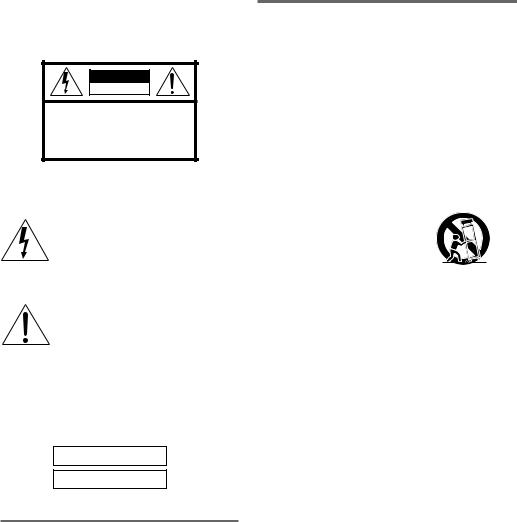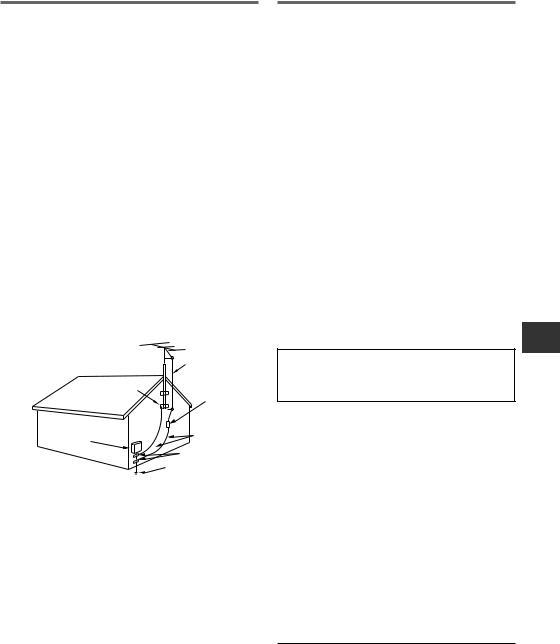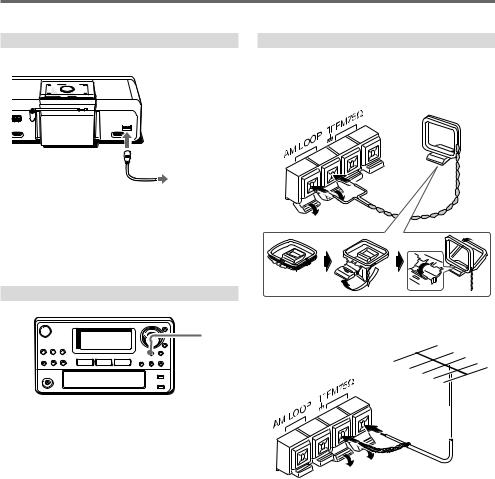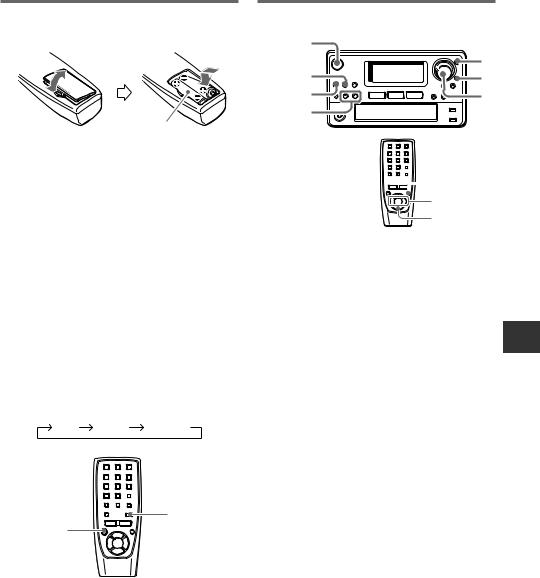Aiwa CSD-NS1 User Manual

|
|
|
CSD-NS1 |
OPERATING INSTRUCTIONS |
|||
INSTRUCCIONES DE MANEJO |
|||
MODE D’EMPLOI |
DIGITAL AUDIO SYSTEM |
||
|
|
|
SISTEMA DE AUDIO DIGITAL |
|
|
|
SYSTÈME AUDIO-NUMÉRIQUE |
English : See page 2. |
En |
|
|
|
|
Español : Ver la página 14. |
E |
|
|
|
|
Français : Voir page 26. |
F |
|
|
8B-CH1-903-01
010325ACK-I-IN
U

WARNING
TO REDUCE THE RISK OF FIRE OR ELECTRIC SHOCK, DO NOT EXPOSE THIS APPLIANCE TO RAIN OR MOISTURE.
CAUTION |
RISK OF ELECTRIC SHOCK |
DO NOT OPEN |
“CAUTION:TO REDUCE THE RISK OF |
ELECTRIC SHOCK, |
DO NOT REMOVE COVER (OR BACK). |
NO USER-SERVICEABLE PARTS INSIDE. |
REFER SERVICING TO QUALIFIED |
SERVICE PERSONNEL.” |
Explanation of Graphical Symbols:
The lightning flash with arrowhead symbol, within an equilateral triangle, is intended to alert the user to the presence of uninsulated “dangerous voltage” within the product’s enclosure that may be of sufficient magnitude to constitute a risk of electric shock to persons.
The exclamation point within an equilateral triangle is intended to alert the user to the presence of important operating and maintenance (servicing) instructions in the literature accompanying the appliance.
OWNER’S RECORD
For your convenience, record the model number (you will find it at the bottom of the unit) and serial number (you will find it on the rear of the unit) in the space provided below. Please refer to them when you contact your AIWA dealer in case of difficulty.
Model No.
Serial No.
Precautions
Read the Operating Instructions carefully and completely before operating the unit. Be sure to keep the Operating Instructions for future reference. All warnings and cautions in the Operating Instructions and on the unit should be strictly followed, as well as the safety suggestions below.
Installation
1Water and moisture - Do not use this unit near water, such as near a bathtub, washbowl, kitchen sink, laundry tub, in a wet basement, swimming pool, or the like.
2Heat - Do not use this unit near sources of heat, including heating vents, stoves, or other appliances that generate heat.
2 ENGLISH
It also should not be placed in temperatures less than 5°C (41°F) or greater than 35°C (95°F).
3Mounting surface - Place the unit on a flat, even surface.
4Ventilation - The unit should be situated with adequate space around it so that proper heat ventilation is assured.
Allow 10 cm (4 in.) clearance from the rear and the top of the unit and 5 cm (2 in.) from each side.
-Do not place the unit on a bed, rug, or similar surface that may block the ventilation openings.
-Do not install the unit in a bookcase, cabinet, or airtight rack where ventilation may be impeded.
5Objects and liquid entry - Take care that objects or liquids do not get inside the unit through the ventilation openings.
6Carts and stands - When placed or mounted on a stand or cart, the unit
should be moved with care. Quick stops, excessive force, and
uneven surfaces may cause the unit or cart to overturn or fall.
7Condensation - Moisture may form on the CD pickup lens when:
-The unit is moved from a cold spot to a warm spot
-The heating system has just been turned on
-The unit is used in a very humid room
-The unit is cooled by an air conditioner
When this unit has condensation inside, it may not function normally. Should this occur, leave the unit for a few hours, then try to operate again.
8Wall or ceiling mounting - The unit should not be mounted on a wall or ceiling, unless specified in the Operating Instructions.
Electric Power
1Power sources - Use on AC house current, as specified in the Operating Instructions and marked on the unit.
2Polarization - As a safety feature, some units are equipped with polarized AC power plugs which can only be inserted one way into a power outlet. If it is difficult or impossible to insert the AC power plug into an outlet, turn the plug over and try again. If it still does not easily insert into the outlet, please call a qualified service technician to service or replace the outlet. To avoid defeating the safety feature of the polarized plug, do not force it into a power outlet.
3AC power cord
-When disconnecting the AC power cord, pull it out by the AC power plug. Do not pull the cord itself.
-Never handle the AC power plug with wet hands, as this could result in fire or shock.
-Power cords should be firmly secured to avoid being bent, pinched, or walked upon. Pay particular attention to the cord from the unit to the power socket.
-Avoid overloading AC outlets and extension cords beyond their capacity, as this could result in fire or shock.

4Extension cord - To help prevent electric shock, do not use a polarized AC power plug with an extension cord, receptacle, or other outlet unless the polarized plug can be completely inserted to prevent exposure of the blades of the plug.
5When not in use - Unplug the AC power cord from the AC outlet or remove all the batteries if the unit will not be used for several months or more. When the cord is plugged in, a small amount of current continues to flow to the unit, even when the power is turned off.
Outdoor Antenna
1Power lines - When connecting an outdoor antenna, make sure it is located away from power lines.
2Outdoor antenna grounding - Be sure the antenna system is properly grounded to provide protection against unexpected voltage surges or static electricity build-up. Article 810 of the National Electrical Code, ANSI/NFPA 70, provides information on proper grounding of the mast, supporting structure, and the lead-in wire to the antenna discharge unit, as well as the size of the grounding unit, connection to grounding terminals, and requirements for grounding terminals themselves.
Antenna Grounding According to the National Electrical Code
ANTENNA LEAD IN WIRE
ANTENNA DISCHARGE GROUND CLAMP  UNIT
UNIT
(NEC SECTION 810-20)
ELECTRIC |
GROUNDING |
SERVICE |
CONDUCTORS |
EQUIPMENT |
(NEC SECTION 810-21) |
|
GROUND CLAMPS |
|
POWER SERVICE GROUNDING |
|
ELECTRODE SYSTEM |
|
(NEC ART 250 PART H) |
NEC-NATIONAL ELECTRICAL CODE
Maintenance
Clean the unit only as recommended in the Operating Instructions.
Damage Requiring Service
Have the units serviced by a qualified service technician if:
-The AC power cord or plug has been damaged
-Foreign objects or liquid have got inside the unit
-The unit has been exposed to rain or water
-The unit does not seem to operate normally
-The unit exhibits a marked change in performance
-The unit has been dropped, or the cabinet has been
damaged
DO NOT ATTEMPT TO SERVICE THE UNIT YOURSELF.
Specifications
Tuner section
Frequency range, antenna – FM: 87.5 - 108.0 MHz, Rod antenna, FM antenna terminal: 75 ohms (unbalanced). AM: 530/531 - 1,710/1,602 kHz (10/9 kHz step), AM loop antenna.
Deck section
Track format – 4 tracks, 2 channels / Frequency range
–Normal tape: 50 - 12,500 Hz (EIAJ) / Recording system – AC bias / Erasing system – AC erase / Heads
–Recording/playback head (1), Erasure head (1)
CD player section |
|
Disc – Compact disc / Scanning method – Non-contact |
|
optical scanner (semiconductor laser) |
|
General |
|
Speaker – 100 mm cone type (2) / Output – |
|
Headphones jack (stereo mini-jack) / Power output – |
|
10 W + 10 W (EIAJ, 4 ohms, T.H.D. 10%) / Power |
|
requirements – AC 120 V, 60 Hz / Power consumption – |
|
40 W / Power consumption in standby mode – With |
|
ECO mode on: 1.2 W, With ECO mode off: 9.4 W / |
|
Dimensions (W × H × D) – 482 × 168 × 231 mm (19 × |
|
6 5/8 × 9 1/8 in.) / Weight – 6.7 kg (14 lbs. 12 oz.) / |
|
Accessories – Remote control (1), AC cord (1), AM loop |
|
antenna (1) |
|
Specifications and external appearance are subject to |
|
change without notice. |
En |
|
|
COPYRIGHT |
|
Please check the copyright laws relating to |
|
recordings from disc, radio or external tape for the |
|
country in which the machine is being used. |
|
If an erroneous display or malfunction occurs
Turn off the unit and press POWER 6STANDBY/ON while pressing s.
If the unit cannot be reset in the way above, disconnect the AC cord to turn off the display.
Leave the unit for a while and turn the power back on.
ENGLISH 3

Power supply
Using on AC house current
Connect the AC cord as illustrated below.
1 to the AC inlet of
the unit
supplied AC cord
2 to an AC outlet (AC 120 V, 60 Hz)
The rated voltage of the unit is 120 V AC.
CAUTION
Use only the supplied AC cord. Use with other cords may result in the risk of fire.
Power economizing (ECO) mode
ECO
Setting the unit to the ECO mode reduces the power consumption while the unit is turned off (standby).
•When the clock is set for the first time, the ECO mode is automatically activated.
•In the ECO mode, everything on the display goes out and only the POWER 6STANDBY indicator lights up.
To cancel the ECO mode
Press ECO while the power is off.
The clock is always displayed while the power is off. To restore the ECO mode, repeat the above.
Power consumption in standby mode with ECO mode on: 1.2 W
with ECO mode off: 9.4 W
Connecting antennas
Connect the AM loop antenna to the AM LOOP terminals on the rear of the unit. Keep the antenna away from metallic objects, electrical equipment and cords.
For better FM reception, connect an outdoor antenna to the FM 75 Ω terminals.
4 ENGLISH

Remote control
Insert two R6 (size AA) batteries.
R6 (AA)
•When the reach of the remote control signal is less than 5 meters (16 feet), replace the batteries.
•Remove the batteries if the remote control is not going to be used for a long time.
The remote control may not operate correctly when:
-The unit is exposed to intense light, such as direct sunlight
-Objects block the remote control signal to the unit
To use the buttons on the remote control
Buttons on the remote control and the main unit with identical or similar indications have the same functions.
To turn the power on
Press POWER to turn on the display.
To turn the power off
Press POWER to turn off the display.
To use the FUNCTION button
Each time FUNCTION is pressed while the power is on, the function is selected cyclically.
CD TAPE TUNER
FUNCTION
POWER
Setting the clock |
|
POWER |
|
6STANDBY |
3 |
indicator |
|
s |
1 |
|
|
3 |
2 |
r, t |
|


 a r, t
a r, t
s
When the AC cord is connected for the first time, the clock display flashes. Set the time.
1 Press TIMER.
“5” flashes in the display.
2 Turn VOLUME/TIMER to adjust the clock.
ror tis also available. Holding it down |
En |
changes the time in 20-minute units. |
3 Press ENTER or ato complete the setting.
The clock starts from 00 seconds.
NOTE
When the clock is set for the first time, everything on the display goes out and the POWER 6STANDBY indicator lights up. This is because the power economizing mode is automatically activated. The power economizing mode can be cancelled (see page 4).
To display the current time
Press TIMER.
To cancel the clock display while the power is on, press it three times or one of the function buttons. While the power is off in the power economizing mode, press TIMER again.
To switch to the 12/24-hour standard
Press TIMER to display the clock and press s.
In the 12-hour standard, “AM 12:00” indicates midnight and “PM 12:00” indicates noon.
If the clock display flashes while the power is off
This is caused by a power interruption. Reset the clock. A long power interruption will clear all the memories such as preset stations and timer settings.
ENGLISH 5
